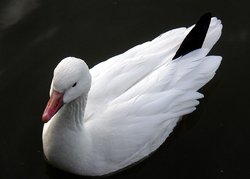Snow Goose
|
|
| Snow Goose Conservation status: Lower risk (lc) | ||||||||||||||
|---|---|---|---|---|---|---|---|---|---|---|---|---|---|---|
 | ||||||||||||||
| Scientific classification | ||||||||||||||
| ||||||||||||||
| Binomial name | ||||||||||||||
| Anser caerulescens (Linnaeus, 1758) Template:Taxobox begin synonyms Template:Taxobox synonym entry simple Template:Taxobox end synonyms |
The Snow Goose (Anser caerulescens) is a North American species of goose. Its name derives from the typically white plumage.
The American ornithologist, David Sibley, places this species and the other North American "white" geese in the genus Chen, rather than the more traditional "grey" goose genus Anser. The Snow Goose is then classed as Chen caerulescens.
SnowGooseBoaqueDelApache2.jpg
This goose breeds in northern Canada and the northeastern tip of Siberia, and winters much further south in the continent in the southern USA and beyond. These birds migrate in large flocks, often visiting traditional stopover habitats in spectacular numbers.
A larger race of this bird, the Greater Snow Geese (A. c. atlanticus), nests to the north of eastern Canada. The smaller race, the Lesser Snow Goose (A. c. caerulescens), occurs in two plumage variants. White phase birds are white except for black wing tips, but blue phase geese have bluish plumage replacing most of the white except on the head, neck and tail tip. White and blue phase birds do interbreed and the young may be of either type. Blue phase birds are rare among the Greater Snow Geese.
SnowGooseBoaqueDelApache4.jpg
This species is a rare vagrant to Europe, but a frequent escape from collections and an occasional feral breeder.
The nest is usually located in a slightly-elevated location on the ground, built with plant material and lined with down.
These birds mainly eat plant material, found in shallow water or on land. Outside of the nesting season, they usually feed in flocks. In winter, these birds feed on left-over grain in fields.
The population of Greater Snow Geese was in decline at the beginning of the 20th century, but has now recovered to sustainable levels.
The number of Snow Geese has increased to the point where the tundra breeding areas in the Arctic and the saltmarsh wintering grounds are both becoming severely degraded, and this affects other species using the same habitat. Extending hunting of this wary species has made no significant impact on numbers.
External link
- US Fish & Wildlife Service (http://migratorybirds.fws.gov/issues/snowgse/tblcont.html)bg:Снежна гъска
de:Schneegans fr:Oie des neiges nl:Sneeuwgans ja:ハクガン pl:Śnieżyca duża sl:Snežna gos
Categories: Anser | Geese

